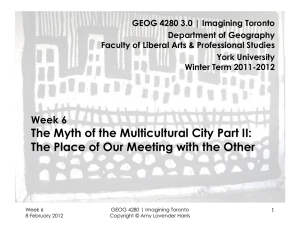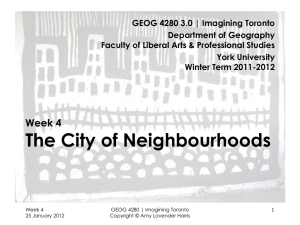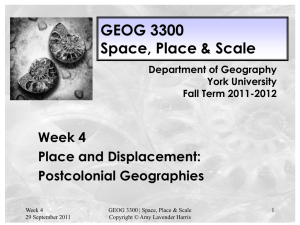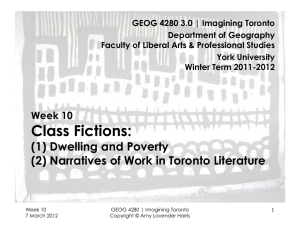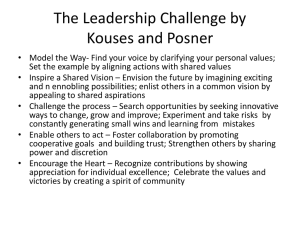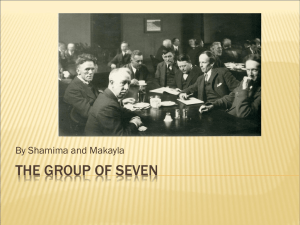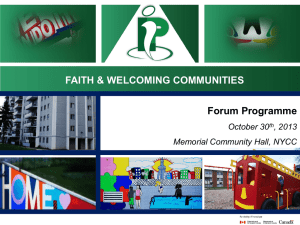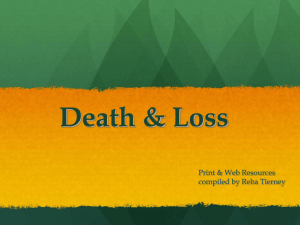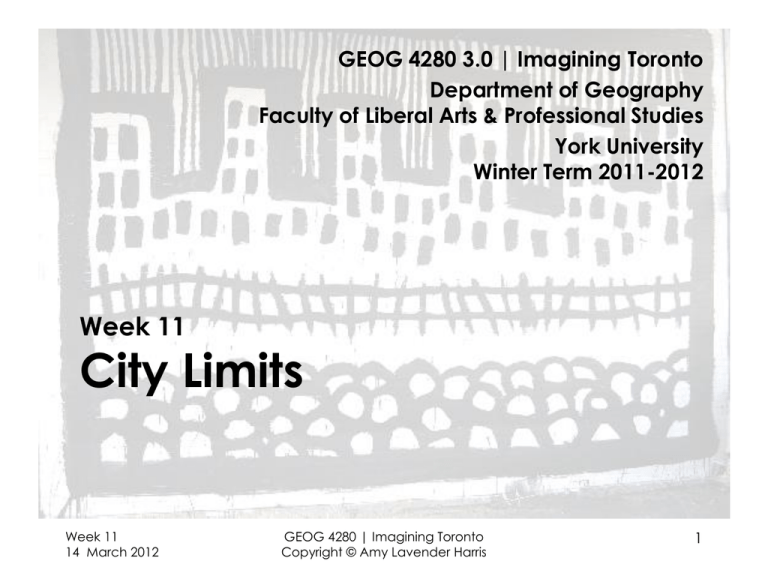
GEOG 4280 3.0 | Imagining Toronto
Department of Geography
Faculty of Liberal Arts & Professional Studies
York University
Winter Term 2011-2012
Week 11
City Limits
Week 11
14 March 2012
GEOG 4280 | Imagining Toronto
Copyright © Amy Lavender Harris
1
“Eighty percent of everything ever built in America has been built in
the last fifty years, and most of it is depressing, brutal, ugly,
unhealthy, and spiritually degrading – the jive-plastic commuter
tract home wastelands, the Potemkin village shopping plazas
with their vast parking lagoons, the Lego-block hotel complexes,
the “gourmet mansardic” junk-food joints, the Orwellian office
“parks” featuring buildings sheathed in the same reflective glass
as the sunglasses worn by chain-gang guards, the particle-board
garden apartments rising up in every meadow and cornfield, the
freeway loops around every big and little city with their clusters of
discount merchandise marts, the whole destructive, wasteful,
toxic, agoraphobia-inducing spectacle that politicians proudly
call “growth.”
James Howard Kunstler, 1993. The Geography of Nowhere.
Week 11
14 March 2012
GEOG 4280 | Imagining Toronto
Copyright © Amy Lavender Harris
2
“The suburban is seen, if at all and at best, as
a consequence, an excrescence, a
cancerous fungus, leaching the energy of
the city, dependent and inert and ultimately
self-destructive.”
Silverstone, 1997. Visions of Suburbia. London; New York: Routledge: 4.
Week 11
14 March 2012
GEOG 4280 | Imagining Toronto
Copyright © Amy Lavender Harris
3
“When you stood next to Willow Creek, held your breath, and
listened to the sounds of the shallow waters flowing by, you
could almost imagine you weren’t a few hundred yards
from a soulless subdivision. [...] What had this entire area
looked like before the developers took over? What had
the land where our house now stood been before the
surveyors marked out where the streets would go, and the
bulldozers came in and levelled everything? Had it been
woodlands? Had it been farmland? Did corn used to come
out of the ground where we now parked the cars? How
many birds and groundhogs and squirrels had to relocate
once the builders broke ground on Valley Forest Estates?”
Linwood Barclay, 2004. Bad Move. New York: Bantam: 36-37.
Week 11
14 March 2012
GEOG 4280 | Imagining Toronto
Copyright © Amy Lavender Harris
4
In Joyland (ECW Press, 2006), Emily Schultz
describes suburbia as the kind of place
where “nothing changed except the
television commercials” (34) and where
“parents were without history, without
future.” (53)
Week 11
14 March 2012
GEOG 4280 | Imagining Toronto
Copyright © Amy Lavender Harris
5
“They come down in the morning and stay all day,
season after season, catching, climbing,
growing—creating worlds where they make the
rules. You three know what I’m talking about.
Except that you’re almost too old for the ravine,
aren’t you? You’ve already left your own part—
the part you know. The creek is your childhood,
and you are following it to where it ends.”
Richard Scrimger, Into The Ravine. Tundra, 2007.
Week 11
14 March 2012
Imagining Toronto
Copyright © Amy Lavender Harris
6
“He and mum made out alright. A split-level ranchstyle prefab in a freshly bulldozed subdivision
with a winterized garage equipped with a colour
TV and beer fridge for him, wall-to-wall
everything inside the house for her (pink hand
towels you don’t dare dirty proudly on display on
the bathroom counter, a rock garden out back
just like the one she saw on Home and Garden
Television), they got the stuff they wanted.
Ray Robertson, 2005. Gently Down the Stream. Toronto: Cormorant:
64-65.
Week 11
14 March 2012
GEOG 4280 | Imagining Toronto
Copyright © Amy Lavender Harris
7
“They pulled into the driveway of the house James had grown
up in and James saw his father in a circle of light on the
front law. He was kneeling, his head close to the grass and
his bum in the air. He wore shorts, and his legs were white.
His bald patch glowed; the spotlight was over the garage
door. James called to him as he opened the car door, but
his father only grunted. He seemed to be scrabbling at
something in the grass. […] Mr. Willing hauled himself up,
patting his grass-imprinted knees. His face was red with
exertion. He held a small ruler in his hand. “Just measuring.
I tell Georg to keep it exactly two point five centimetres,
but there are patches where it varies. I’ll have to speak to
him.” He waved at the far edge of the lawn. “Burnt patches
over there, too, I think it’s some kind of fungus, from having
leaves on it too long. I told him.”
Russell Smith, 1998. Noise. Erin, ON: Porcupine’s Quill: 159.
Week 11
14 March 2012
GEOG 4280 | Imagining Toronto
Copyright © Amy Lavender Harris
8
“This was the historic community of Port Junction,
you see. It was considered one of the last
remaining ‘good’ parts of Scarborough, meaning
distant from the growing ethnic neighbourhoods
to the west. There were no highrises here, and
the homes were almost all new and fully
detached. […] There was also a large sign farther
down the main road, originally put up by a
property developer but maintained by the
community thereafter. The sign read ‘Old Port
Junction: The Traditional Community by the
Lake.’”
David Chariandy, Soucouyant. Arsenal Pulp Press, 2007: 60.
Week 11
14 March 2012
Imagining Toronto
Copyright © Amy Lavender Harris
9
“Also, there was the annual Heritage Day parade.
Every year in spring, our neighbours would
organize a march that would pass by the main
road just beyond our cul-de-sca. The flyers
explained that everyone was invited to
participate, since the Heritage Day parade was
being revamped these days to recognise
‘people of multicultural backgrounds’ and ‘not
just Canadians.”
Ibid.: 60.
Week 11
14 March 2012
Imagining Toronto
Copyright © Amy Lavender Harris
10
“Nothing [...] of any consequence ever really
happens on a crescent. These are the sites of
complacent banality, of the here and now, of
everydayness. Art is about the there and then.
Excitement takes place elsewhere. […] [M]any
writers represent the suburbs as soulless and their
families as dysfunctional. More often than not,
the suburbs are represented as sites of everyday
monotony leading to dissatisfaction or as the
quiet backdrop against which gothic horror or
absurdity takes place.”
Milton, Paul, 2005. “Rewriting White Flight: Suburbia in Gerald Lynch’s
Troutstream and Joan Barfoot’s Dancing in the Dark. In Downtown
Canada: Writing Canadian Cities, eds. Justin D. Edwards and Douglas
Ivison, 166-182. Toronto: University of Toronto Press.
Week 11
14 March 2012
GEOG 4280 | Imagining Toronto
Copyright © Amy Lavender Harris
11
Suburban Gothic
• In Blind Crescent (2005), Michelle Berry’s unsettling novel
set in an unnamed Ontario suburb, six houses on a cul-desac harbour residents separated by a common but
unspoken crisis.
• A gunman stalks the metropolitan highways around Blind
Crescent, and as the novel unfolds with deliberate
DeLilloesque detail, it seems possible that the shooter
could be any one of the people living on Blind Crescent.
Even the unlikely suspects are marked by silent complicity,
noticing disturbing patterns of neighbourhood behaviour
but remaining too caught up in the minutiae of private
misery even to protect themselves.
Week 11
14 March 2012
GEOG 4280 | Imagining Toronto
Copyright © Amy Lavender Harris
12
• In Bad Move (Linwood Barclay, 2004), set in a thinly fictionalized
version of Oakville, a downtown homeowner tires of the nightly
accumulation of condoms and crack pipes in his Toronto
neighbourhood and moves his family to a suburb where he
quickly concludes boredom must be the leading cause of death.
• Shortly thereafter, troubling discoveries begin to tarnish his
tranquility; among them the revelation that the neighbourhood
accountant moonlights as a dominatrix and the landscaper living
across the street uses his garage as a grow-op. Even more
alarming is his growing suspicion that the subdivision’s land
development corporation is controlled by the mob.
• Zack’s diminishing peace is shattered permanently when he
stumbles across the bludgeoned corpse of a local environmental
activist floating face down in a local creek. Caught up in an
escalating cycle of extortion and murder, Zack realizes far too
late that suburbia cannot provide an escape from the violent
proclivities people carry with them.
Week 11
14 March 2012
GEOG 4280 | Imagining Toronto
Copyright © Amy Lavender Harris
13
• Novels depicting cruelty and criminality in suburban settings may
be traced to the origins of contemporary Canadian suburbia.
• One of the earliest, Hugh Garner’s Death in Don Mills, set in what
urban analyst John Sewell calls “Canada’s first corporate
suburb,” contrasts the bland, orderly reputation of 1970s-era Don
Mills with the sordid reality of activities transacted behind the
community’s closed doors.
• A married businessman, dropping off a neatly wrapped packet of
waste before embarking on his precisely timed morning
commute, discovers the naked body of his neighbour, stabbed
and stuffed into the garbage chute of their otherwise immaculate
Don Mills apartment building.
• police investigation exposes the dead woman’s private
predilection for booze, boys and promiscuous sex and, more
tellingly, uncovers a tangled network of drug dealers, sexual
“deviants,” sociopaths and killers living at 1049 Don Mills Road
and permeating the community at large.
Week 11
14 March 2012
GEOG 4280 | Imagining Toronto
Copyright © Amy Lavender Harris
14
The Suburban Mystique
“If you had been a stranger from another planet, you might have
wondered if Rowanwood was inhabited at all. You would not
have understood the phenomenon of mid-morning doldrums.
You had to live in Rowanwood to know that the men had all left
the boxes in which they lived for other boxes in the business
section downtown; to know that the women were either hidden
inside cleaning the former, or had gone off in smaller
mechanized boxes to the shopping plaza. These things explained
to you, you, the stranger from another planet, would still fail to
understand why the women should spend so much time shut up
in their boxes. You would, if you had come equipped with any
knowledge of the civilization you had invaded, wonder how on
Earth women had allowed themselves to be hoodwinked into
believing what the manufacturers wanted them to believe—that
they had never had it so good.”
Phyllis Brett Young, 1960. The Torontonians. Toronto: Collins: 55.
Week 11
14 March 2012
GEOG 4280 | Imagining Toronto
Copyright © Amy Lavender Harris
15
The Myth of the Monocultural Suburb
• In White Diaspora, literary scholar Catherine Jurca
suggests that the eschatological quality present in so
many suburban novels reflects their authors’ collective
sense of cultural loss.
• Since the late nineteenth century middle and upper class
North Americans have migrated to suburbs to escape
conditions they feared or found distasteful about cities:
overcrowding, pollution, poverty and (as the welldocumented phenomenon of “white flight” indicates)
immigration and ethnic diversity.
• Ultimately, Jurca argues, these fears have shown up in
novels portraying their middle-class suburban protagonists
as members of a diaspora driven from cities, seeking an
Anglo-Saxon homeland but finding themselves perennially
displaced at the urban fringe.
Week 11
14 March 2012
GEOG 4280 | Imagining Toronto
Copyright © Amy Lavender Harris
16
• Ironically invoking the language of dispossession, Jurca
explains that “the term white diaspora is designed to
emphasize and lay bare the role of the novel in promoting
a fantasy of victimization that reinvents white flight as the
persecution of those who flee, turns material advantage
into artifacts of spiritual and cultural oppression, and
sympathetically treats affluent house owners as the
emotionally dispossessed.” Jurca, 2001:8-9.
Week 11
14 March 2012
GEOG 4280 | Imagining Toronto
Copyright © Amy Lavender Harris
17
The Long History of Suburbia
• In The Urban Experience, geographer David Harvey
reminds us that a city—and its suburbs—should be
understood as a process rather than a thing.
• In this light, it is important to remember that Toronto’s
suburbs did not appear out of nowhere at mid-century,
emerging all at once from the landscape like earthbound
Leviathans.
• In his 1898 book, Toronto the Good, C.S. Clark wrote of the
city’s diurnal migration of suburbanites who “come down
every morning to [do] business in crowds between the
hours of seven and nine, and literally pour out of it
between the hours of four and seven in the evening.”
• The suburban commuters Clark refers to are mainly the
wealthy inhabitants of Rosedale, Moore Park and the
Annex, at the time still distinguished from the rest of the city
by a combination of social class and legal jurisdiction.
Week 11
14 March 2012
GEOG 4280 | Imagining Toronto
Copyright © Amy Lavender Harris
18
• At the same time, however, working class suburbs had also
begun to make their muddy appearance in undeveloped
areas west of the city.
• In Unplanned Suburbs, geographer Richard Harris traces
the development of these communities, established
through the subdivision of large landholdings into building
lots purchased primarily by immigrants attracted to
industrial jobs located along the Grand Trunk and
Canadian Pacific rail lines. Some residents bought
developer-built homes in rapidly growing industrial suburbs
like the Town of West Toronto Junction but many others
settled in an area known as “the Shackland,” a district of
self-built homes and squatters’ shanties centred on St. Clair
in the Earlscourt area around Dufferin Street and extending
west into the Junction.
Week 11
14 March 2012
GEOG 4280 | Imagining Toronto
Copyright © Amy Lavender Harris
19
• Working class suburbs were not only a phenomenon of the
early part of the century. An acute housing shortage and a
surge in European immigration following the Second World
War spurred new growth on the city’s outskirts well before
incorporated subdivisions like Don Mills, marketed to the
middle class, came to dominate the suburban landscape.
• In The Suburban Society, a study of urban change in midcentury Toronto, Sociologist Samuel Clark described the
bulk of suburban residents as “people in impoverished
circumstances prepared to accept whatever the country
had to offer them.” In many cases what these residents—
many of whom were war veterans or refugees—were
prepared to accept were unserviced, undeveloped
building lots available for a few hundred dollars.
Week 11
14 March 2012
GEOG 4280 | Imagining Toronto
Copyright © Amy Lavender Harris
20
• In Pioneering in North York, historian Patricia Hart refers to
these suburbanites as “the New Pioneers,” writing that
“many bought land and started to build their own houses.
They dug basements, covered them over, then paused to
regroup their finances, and as the idea became known,
others followed suit. They were somewhat derisively called
“cave dwellers.” Slowly, these houses have been finished,
sometimes after a nudge from the municipal authorities,
but for a number of years “cave dwellers” walked daily to
a pump near the centre of the community for water. (Hart,
1968: 268.)
Week 11
14 March 2012
GEOG 4280 | Imagining Toronto
Copyright © Amy Lavender Harris
21
• In Buying on Time (1997), a collection of linked stories,
Antanas Sileika describes a family from Lithuania,
displaced by the ravages of the Second World War, who
buy a building lot in an undeveloped corner of Weston:
“Our street had half a dozen other houses on it, but none
of them were finished. People dug the foundations and
laid the basement blocks. Then they waited and saved.
When a little money came in, they bought beams and
joists and studs. Then they waited some more. The
Taylors stood out because a contractor had built their
house from start to finish. We stood out too. We moved
in before the above-ground walls went up.
“You want us to live underground?” my mother had
asked. “Like moles? Like worms?”
“No,” my father said, “like foxes.”
Week 11
14 March 2012
GEOG 4280 | Imagining Toronto
Copyright © Amy Lavender Harris
22
• “It was true that others lived in houses that were already
built, while we lived in the basement as the house was
being raised above us. But normal houses belonged to
that other race of people, Canadians, who wore suits to
work. Before the basement, we had lived in a rented
wooden shack on the edge of a farm. Before that there
had been the DP camp in Germany, which I couldn’t
remember much, except for all the bomb craters filled with
water where the children fished hopelessly all day.”
• Their sense of arrival grows nearly complete when a
Canadian family moves into a tar-paper shack down the
street, cramming nine children into a tattered dwelling with
an outhouse and rutted yard. “Now that our outhouse was
gone,” Sileika’s narrator reflects, “we had someone we
could look down on.”
Week 11
14 March 2012
GEOG 4280 | Imagining Toronto
Copyright © Amy Lavender Harris
23
The New Torontonians
• Postcolonial scholars, chief among them Homi Bhabha (The
Location of Culture, 1994) and Gayatri Spivak (“Can the Subaltern
Speak,” 1988), use the language of subalternity to account for
self-narratives in which cultural minorities, having absorbed
negative images embedded in the dominant discourse, judge
themselves on colonial or racist criteria.
• In postcolonial scholarship the term “subaltern” is appropriated
from its military and even Gramscian contexts and used to refer
to the marginalizing effects of colonialism on the identity and selfnarratives of those who have been objectified or ‘Othered’ by an
oppressive cultural hegemony.
• Dionne Brand articulates this vulnerability eloquently in What We
All Long For, describing a Vietnamese family who, despite having
accumulated material wealth in the years since arriving as
refugees, find their accomplishments remain inadequate and the
suburban dream elusive:
Week 11
14 March 2012
GEOG 4280 | Imagining Toronto
Copyright © Amy Lavender Harris
24
“Tuyen’s family is rich, newly rich. They have a giant house in
Richmond Hill, where rich immigrants live in giant houses.
Richmond Hill is a sprawling suburb where immigrants go to get
away from other immigrants, but of course they end up living with
all the other immigrants running away from themselves – or at
least running away from the self they think is helpless, weak,
unsuitable, and always in some kind of trouble. […] They hate
that self that keeps drawing attention, the one that can’t fit in
because of colour or language, or both, and they think that
moving to a suburb will somehow eradicate that person once
and for all. And after all the humiliations of being that self—after
they’ve worked hard enough at two or three jobs and saved
enough by overcrowding their families in small dour rooms and
cobbled together enough credit—immigrants flee to rangy
lookalike desolate suburbs like Richmond Hill where the houses
give them a sense of space and distance from that troubled
image of themselves. “
Dionne Brand, 2005. What We All Long For. Toronto: Knopf: 54-55.
Week 11
14 March 2012
GEOG 4280 | Imagining Toronto
Copyright © Amy Lavender Harris
25
• Toronto-born Tuyen considers her parents’ house artificial,
and observes that “[t]he whole development seemed
highly contrived, as if it were made all of cardboard and
set down quickly and precariously. Someone’s idea of
luxury, which was really antiseptic, and for all its cars and
spaciousness, it was nevertheless rootless and desolate.
• But to her parents, the big suburban house is meant to
project the image of arrival, as if at long last it will enable
them to escape their memories of flight and foreignness,
and the fear that in some important way they will always
remain refugees, adrift forever on a crowded boat on the
South China Sea.
• Dreams of suburban homeownership and attendant
images of security and arrival also feature prominently in
Rabindranath Maharaj’s novel, Homer in Flight. But where
Maharaj’s protagonist, a recent immigrant from Trinidad,
has hoped to find stability and order, he experiences
social isolation and crushing loneliness instead.
Week 11
14 March 2012
GEOG 4280 | Imagining Toronto
Copyright © Amy Lavender Harris
26
• At first the city’s order impresses Homer, its immaculate
streets a striking contrast to the corruption and humid
decay that had compelled him to leave Trinidad. During
the hour-long car trip from Toronto’s international airport to
his cousin’s suburban home on the eastern outskirts of the
city, Homer marvels at the tidy landscape of subdivisions
and factories they pass while driving along highway 401:
• “Age does not bring dereliction here, Homer thought;
everything is well preserved: the houses, the landscape,
the people. He focused on the neatness: each house was
embellished with a colourful garden, a well-maintained
lawn and a tree. They all looked similar. He felt that if he
closed his eyes and opened them after one minute, he
would not notice any difference. Just like a Flintstones
cartoon, with the same building appearing over and over,
he thought.” (Maharaj, 1997: 23-24)
Week 11
14 March 2012
GEOG 4280 | Imagining Toronto
Copyright © Amy Lavender Harris
27
• Surprised to hear the name of the suburban community his
cousin Grants lives in, Homer asks, somewhat rhetorically,
“Ajax? Like the bleach cleaner?”
• In Ajax—named after a battleship, Homer is informed—he
settles into his cousin’s basement and dreams of home
ownership and big American cars. A conversation with
Grants explains the significance of his cousin’s suburban
address:
• “I ... we bought the house during the boom years. Cost a
fortune then. There was plenty money around and
immigrants were buying houses left, right and centre. They
still do, you know. Other Canadians are different from us.
They see nothing wrong about living their entire lives
renting an apartment or condo, but in the back of every
immigrant’s mind there is always one fixed thought: when
can I afford a house? It gives us security. Security.” (Ibid.:
23; 38.)
Week 11
14 March 2012
GEOG 4280 | Imagining Toronto
Copyright © Amy Lavender Harris
28
• But the security Grants enjoys eludes Homer. Moving to
Etobicoke in search of work, he rents an ill-furnished high
rise apartment and joins a ragged army of immigrant men
who toil at low-paying factory jobs in the city’s industrial
suburbs. Early one morning, travelling home exhausted
and dirty after a long night shift, he realizes how far away
his dreams have become:
Week 11
14 March 2012
GEOG 4280 | Imagining Toronto
Copyright © Amy Lavender Harris
29
“The bus arrived and Homer slipped his two loonies into the
slot and headed for a seat at the back. Young women on
their way to offices, immaculately attired, sat at the front,
while closer to Homer were ragged-looking middle aged
men with dirty knapsacks between their legs and overused
safety boots. [...] Perhaps it was because they looked tired
and sleepy, but Homer could not help thinking that they
appeared ill at ease. Maybe they were all foreigners,
migrants functioning solely on the success stories they had
been told of earlier migrants, enduring the thin comforts of
this life with a fatalistic exhaustion, dreaming of their own
success stories five years from now. Maybe they have
already given up on themselves, Homer thought, their lives
sucked dry, thinking instead of their children. He would
look at the weary men with their slack, expressionless
faces, these men propelled by furtive dreams, and even
though he was operating under different circumstances,
working for himself rather than for any children, he would
suddenly feel frightened.” Ibid.: 73.
Week 11
14 March 2012
GEOG 4280 | Imagining Toronto
Copyright © Amy Lavender Harris
30
• Homer’s sense of liminality is echoed in M.G. Vassanji’s
novel, No New Land. But where Homer experiences
crushing loneliness and social exclusion in suburbs he finds
cold and uninviting, Vassanji’s protagonists are buffered
by a tightly knit cultural community that bolsters their
efforts to make a place for themselves in the new country.
In No New Land, the Lalani family joins an established
community of Tanzanian ex-patriots living in a Don Mills
high rise. Their address, 69 Rosecliffe Park Drive, has
achieved legendary status among South Asians in East
Africa mainly because its inhabitants have recreated their
home city of Dar Es Salaam in the building’s corridors and
common spaces:
Week 11
14 March 2012
GEOG 4280 | Imagining Toronto
Copyright © Amy Lavender Harris
31
“Sixty-nine Rosecliffe Park. The name still sounds romantic,
exotic, out of a storybook or a film. Sometimes it’s hard to
believe you are here, at this address, sitting inside, thinking
these thoughts. [...] But then you step out in the common
corridor with its all too real down-to-earth sights, sounds,
and smells, and you wonder: This, Sixty-nine Rosecliffe?
And you realize that you’ve not left Dar far behind. “Twenty
floors.” Nurdin once did a small calculation for his wife.
“Twelve homes in each—you have two hundred and forty
families—that’s three good-sized blocks of any street in
Dar.” Except that the variety found here at Sixty-nine
would not be found in any street in Dar. Here a dozen
races mingle, conversant in at least as many tongues.”
(Vassanji, 1991: 59-60.)
Week 11
14 March 2012
GEOG 4280 | Imagining Toronto
Copyright © Amy Lavender Harris
32
• Although the lobby doors at 69 Rosecliffe revolve continuously
with departures and arrivals from school or work, other residents
are able to conduct vital commerce without ever needing to
leave the building. Each floor has its speciality: on the sixth level,
Gulshan Bai prepares tiffin for a steady stream of customers who
carry her meals to work in plastic containers; on the fourteenth
floor, Sheru Mama and her husband Ramju make chappatis in
the traditional manner; there is even a halal butcher. It is possible
to buy toiletries at all hours from an apartment on the ground
floor, and a continuous open house operates on the eighteenth
floor where residents play cards, drink tea and share gossip
about Dar and the respective fates of their fellow emigrants.
Encounters in the corridors confirm the presence of practitioners
eager to dispense legal, medical or spiritual advice.
• Awash in familiar faces and routines, 69 Rosecliffe is a slice of
sovereign soil transplanted halfway around the world, a vertical
version of Dar that has just happened to take root in suburban
Don Mills.
Week 11
14 March 2012
GEOG 4280 | Imagining Toronto
Copyright © Amy Lavender Harris
33
• But their parents, making the immigrant sacrifice, despair
that their own prospects are limited because they lack an
acceptable accent and the ephemeral qualification
called “Canadian experience.” Still, the building at 69
Rosecliffe Park, and the weekly mosque held nearby at a
school gymnasium on Eglinton Avenue, represent a start, a
defensible beachhead in this improbable corner of Don
Mills where Dar’s exiles have made their new home.
• As these novels suggest, visible minorities seeking shelter
in Toronto area suburbs routinely encounter bigotry,
poverty and cultural isolation. At the same time, however,
even while underscoring the sort of deep-seated racism
Jurca argues is endemic in suburban literature, Chariandy,
Brand, Maharaj and Vassanji’s novels emphasize another
reality: that Toronto-area suburbs are culturally far more
diverse than broad-brush analyses of North American
suburbia have typically accounted for.
Week 11
14 March 2012
GEOG 4280 | Imagining Toronto
Copyright © Amy Lavender Harris
34
• This is not to say that racial tensions do not exist, but rather
that they are less a cause or consequence of “white flight”
than a product of cultural conflicts analogous to those
found within the inner city itself.
• The prototypical suburb—a white, middle-class bedroom
community segregated from the inner city by race and
income—is increasingly the exception in the greater
Toronto area, where many suburban municipalities,
including Vaughan, Markham and Mississauga, are
culturally more diverse than the downtown core and
where “inner suburbs” like Scarborough and Rexdale
attract large numbers of recent immigrants seeking
affordable housing and who work in mid-city industrial
enclaves.
Week 11
14 March 2012
GEOG 4280 | Imagining Toronto
Copyright © Amy Lavender Harris
35
• Even Don Mills, a community novelist Lawrence Hill describes in
his memoir, Black Berry, Sweet Juice, as being so monoculturally
white in the 1960s that he became conditioned to think of his
black features as ugly, has undergone a profound cultural shift as
residents of Chinese, South Asian and Middle East origin have
trickled into its perimeter while transforming the adjacent high
density inner suburban communities of Flemingdon and
Thorncliffe Park. As geographers Larry Bourne and Damaris Rose
observe laconically, “diversity has suburbanized.”
• Although Don Mills “proper” (the distinctive four-quadrant 1950s
development radiating outward from Lawrence Avenue and Don
Mills Road) remains predominantly white, in 2006 nearly 40% of its
residents self-identified as visible minorities. By contrast, 77% of
Flemingdon Park’s population consists of visible minorities, while
almost 75% of Thornclife Park residents describe themselves as
visible minorities. (source: City of Toronto, Neighbourhood Profiles
for Banbury-Don Mills, Flemingdon Park and Thorncliffe Park).
Week 11
14 March 2012
GEOG 4280 | Imagining Toronto
Copyright © Amy Lavender Harris
36
• The extent to which Toronto’s inner and outer suburbs have
diversified is far more than a merely demographic
measure, however. Diversity is also a quality of the
imagination, marking the invisible moment when the urban
narrative becomes truly representative of the lives lived
within its orbit.
• Seeming to write in anticipation of this moment, in
“Canada Geese and Apply Chatney” Sesanarine Persaud
describes a Guyanese immigrant who wanders the
sprawling parkland of Eglinton Flats in Weston, watching
Canada geese gather before their long migration south for
the winter. Inspired by hunger and recollections of home,
Writerji enlists two friends who wring the necks of enough
geese to fill the freezer of their Emmett Avenue apartment.
A week later the trio visit friends whose Scarborough
apartment overlooks Morningside Park. During their visit
Writerji disappears into the woodland surrounding Highland
Creek and returns with a bounty of crab-apples.
Week 11
14 March 2012
GEOG 4280 | Imagining Toronto
Copyright © Amy Lavender Harris
37
“Next thing he coming back with he hand full a them small
sour apple. He can’t believe all them apple falling on the
grass and wasting. People wasteful in Canada he
muttering over and over. Writerji want help to pick some
nice green apple on them tree. Why? He thinking just like
how yuh use green mango, or bilimbi, or barahar to make
achaar and chatney why not green apple. And right then
mango scarce in Toronto, cost a fortune. Them days was
not like nowadays when you gat West Indian store every
corner. Them days you only get fruits from the West Indies
when anybody coming. But that apple-chatney taste
good with them geese we bring for Prem and Kishore.”
Sasenarine Persaud, Canada Geese and Apple Chatney. TSAR
Books, 1998.
Week 11
14 March 2012
Imagining Toronto
Copyright © Amy Lavender Harris
38
Representations of Suburbia
•
•
•
•
•
•
•
•
•
•
•
•
•
•
1960:
1975:
1989:
1991:
1997:
1997:
1998:
2004:
2005:
2006:
2006:
2007:
2007:
2008:
Phyllis Brett Young’s The Torontonians. [mid-century suburbia]
Hugh Garner’s Death in Don Mills
Barbara Gowdy’s Falling Angels.
M.G. Vassanji’s No New Land. [set in late 1970s Thorncliffe Park]
Anatanas Sileika, Buying on Time [1950s Weston]
Rabindranath Mahraj’s Homer in Flight. [Ajax; Etobicoke]
Sesanarine Persaud, Canada Geese and Mango Chatney
Linwood Barclay’s Bad Move. [Oakville]
Michelle Berry’s Blind Crescent.
Emily Schultz’s Joyland.
Dionne Brand’s What We All Long For. [Richmond Hill]
Richard Scrimger, Into the Ravine. [Scarborough]
David Chariandy, Souccouyant. [Scarborough]
V.V. Ganeshananthan’s Love Marriage. [Scarborough]
Week 11
14 March 2012
GEOG 4280 | Imagining Toronto
Copyright © Amy Lavender Harris
39
Week 11
14 March 2012
GEOG 4280 | Imagining Toronto
Copyright © Amy Lavender Harris
40

